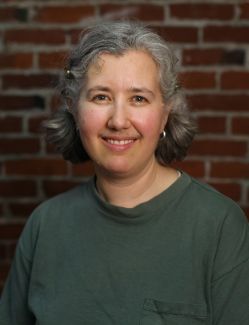
Areas I Teach
Stacey's Lab Home Page
Course Information
At Pacific University, all faculty teach a variety of different courses. Typically, we do not use graduate teaching assistants, which means that your classes will be taught by professors and that you will have plenty of opportunities to get to know the faculty in your discipline.
Below I have listed some of the courses that I teach. We are always developing and trying out new classes, so the list may change now and then.
BIOL 200 | Intro Bio: Flow of Energy
BIOL 404 | Ecology
BIOL 495 | Research
Education
Postdoctoral research in Biological Science, Florida State University, Tallahassee, Fla., from 2003-2005
PhD in Ecology, Evolution and Behavior, University of Minnesota, Minneapolis, Minn., in 2003
Bachelor of Arts in Biology, Carleton College, Northfield, Minn., in 1993
Teaching Philosophy
The impact I’ve seen teacher-scholars have on individuals and on society is the reason I’m passionate about education. To have that impact, I believe it’s essential for teachers to foster student-directed learning and critical thinking. In the classroom, I use case studies and problems that require students to wrestle with concepts and their application to scientific and policy issues. As a research mentor, I allow students the independence to explore questions and techniques while providing sufficient feedback to prevent high-risk errors. In both contexts, I believe these opportunities to practice problem-solving skills and the scientific process encourages students to consider pursuing science as a career or increases their comfort with using science in their lives as citizens.
Research Interests
Plants and insects make up more than half of all known species, and their interactions play key roles in both natural and agricultural systems. Both plants and plant-insect interactions are also strongly affected by changes in the environment, including human-caused changes. I study the responses of plant populations and plant-insect interactions to this environmental variation. I aim to do research that not only addresses fundamental questions in ecology and evolution, but also contributes to understanding and perhaps mitigating the ecological effects of changes caused by human activities.
Recent project: Ecology of invasive plants
Invasive plants may face novel environments in their introduced ranges, and some of these changes may contribute to invasion success. I am interested in how differences in plant-herbivore interactions may affect plant invasions. Currently, my collaborator (Nora Underwood) and I are exploring how density dependence in plant-herbivore interactions might influence plant invasions. In particular, we're interested in the potential effects of insect herbivores on population regulation in an invasive plant.
Publications related to this project (* indicates undergraduate researcher):
Halpern, S. L., D. M. Bednar*, A. Chisholm*, and N. Underwood. 2014. Plant-mediated effects of host plant density on a specialist herbivore of Solanum carolinense. Ecological Entomology: 39: 217-225 DOI: 10.1111/een.12088
McNutt, D.W., S.L. Halpern, K. Barrows*, and N. Underwood. 2012. Intraspecific competition increases the evolutionary potential of tolerance to insect herbivory in the perennial plant Solanum carolinense. Oecologia. 17(4): 1033-1044. DOI 10.1007/s00442-012-2377-x
Underwood, N. and S. L. Halpern. 2012. Insect herbivores, density dependence, and the performance of the perennial herb Solanum carolinense. Ecology 93(5): 1026-1035.
Halpern, S. L. and N. Underwood. 2006. Approaches for testing assumptions about the role of herbivores in plant population dynamics. Journal of Applied Ecology 43: 922-929.
In collaboration with Jean Burns and Alice Winn, I also investigated the traits that may be associated with plant invasiveness. In the group of Dayflowers we studied, invasive species are more opportunistic than non-invasive species—they can take advantage of good conditions (such as low competition or high light availability) with large improvements in performance.
Mentoring Student Research
I believe that participating in research is an important component of an undergraduate education in biology. I enjoy working closely with students on their projects, which make real contributions to my overall research program.
An ideal student research experience involves several components. First, I encourage students to develop their ideas during a semester-long independent study. During this time, students read literature, explore questions, and write a proposal for their project. Then I work closely with students (often over the summer) to carry out their project, including revising plans in the face of the inevitable monkey-wrenches that occur in research. Finally, I help students prepare their projects for formal oral, poster, or written presentation. Students typically present at local or regional conferences, and some participate in writing up results for publication in professional journals.
I encourage students to contact me early in their undergraduate career if they are interested in research.
Other Publications
McNutt, D.W., S.L. Halpern, K. Barrows*, and N. Underwood. 2012. Intraspecific competition increases the evolutionary potential of tolerance to insect herbivory in the perennial plant Solanum carolinense. Oecologia. In press, published on-line June 2012 DOI 10.1007/s00442-012-2377-x
Underwood, N. and S. L. Halpern. 2012. Insect herbivores, density dependence, and the performance of the perennial herb Solanum carolinense. Ecology 93(5): 1026-1035
Underwood, N., S. L. Halpern, and Klein, C.* 2011. Effect of host plant genotype and neighboring plants on strawberry aphid movement in the greenhouse and field. The American Midland Naturalist 165(1): 38-49
Halpern, S. L., L. S. Adler, and M. Wink. 2010. Leaf herbivory and drought stress affect floral attractive and defensive traits in Nicotiana quadrivalvis. Oecologia 163: 961-971. doi:10.1007/s00442-010-1651-z
Burns, J. H., S. L. Halpern, and A. A. Winn. 2007. Do low-quality environments limit the advantages of opportunism in invasive species? Biological Invasions 9: 213-225
Halpern, S.L. and N. Underwood. 2005. approaches for testing assumptions about the role of herbivores in plant population dynamics. Journal of Applied Ecology 43: 922-929
Halpern, S.L. 2005. Sources and consequences of variation in seed size in Lupinus perennis(Fabaceae): Adaptive and non-adaptive hypotheses. American Journal of Botany 92(2): 205-213
McKone, M.M. and S. L. Halpern. 2003. The evolution of androgenesis. The American Naturalist 161(4): 641-656
Paciorek, C.‡*, B. Moyer‡*, R. Levin‡*, and S. L. Halpern‡*. 1995. Pollen consumption by the hummingbird flower mite Proctolaelaps kirmsei and possible fitness effects on Hamelia patens. Biotropica 27(2): 258-262
* author was an undergraduate when research was conducted